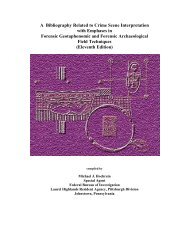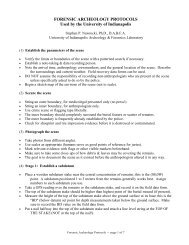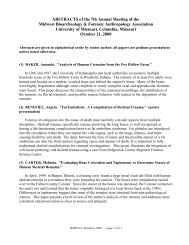Christopher W. Schmidt - University of Indianapolis Archeology ...
Christopher W. Schmidt - University of Indianapolis Archeology ...
Christopher W. Schmidt - University of Indianapolis Archeology ...
Create successful ePaper yourself
Turn your PDF publications into a flip-book with our unique Google optimized e-Paper software.
variation within populations cannot be demonstrated with samples <strong>of</strong> a modest size, particularly<br />
once they are subdivided by sex and age. Rhine undoubtedly chose to group males and females<br />
together and to ignore age because the sample was too small to split up.<br />
In another study, Angel and Kelley (1990) focused solely on two non-metric traits as<br />
ancestral indicators: inversion <strong>of</strong> the posterior border <strong>of</strong> the mandibular ramus and eversion <strong>of</strong><br />
the gonia. They looked at a total <strong>of</strong> 376 females and 406 males spanning 5 generations. Their<br />
sample consisted <strong>of</strong> a number <strong>of</strong> individuals from the Terry collection, forensic cases, two 19th<br />
century African American cemeteries, and Plains Indians. Angel and Kelley determined the<br />
degree <strong>of</strong> inversion and gonial flare by scoring each trait on a four-point scale (absent, slight,<br />
marked, and extremely marked). However, they did not describe these categories or the<br />
boundaries between them, leading to possible confusion in scoring these traits if used by other<br />
researchers.<br />
Inversion <strong>of</strong> the ramus was found to vary between the populations studied. European<br />
Americans had inversion present 30% <strong>of</strong> the time, whereas in African Americans, inversion was<br />
observed in 95% <strong>of</strong> the individuals examined. The Native American population fell between the<br />
European Americans and African Americans, with inversion present 44.5% <strong>of</strong> the time. There is<br />
a significant difference in the amount <strong>of</strong> ramus inversion between European and African<br />
Americans. However, the Native American population is not significantly different from the<br />
European American population.<br />
The results for gonial eversion were more homogenous and do not appear to have<br />
produced any statistically significant differences. European Americans exhibited eversion 77.1%<br />
<strong>of</strong> the time, while African Americans displayed eversion in 89.1% <strong>of</strong> the cases. The smallest<br />
percentage <strong>of</strong> gonial eversion was found in Native Americans, with 63.8% <strong>of</strong> the sample<br />
17








